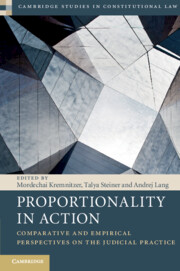Book contents
- Proportionality in Action
- Cambridge Studies in Constitutional Law
- Proportionality in Action
- Copyright page
- Contents
- Figures
- Tables
- Contributors
- Preface
- Cases
- Introduction
- 1 Proportionality Analysis by the German Federal Constitutional Court
- 2 Proportionality Analysis by the Canadian Supreme Court
- 3 Proportionality Analysis by the South African Constitutional Court
- 4 Proportionality Analysis by the Israeli Supreme Court
- 5 Proportionality Analysis by the Polish Constitutional Tribunal
- 6 Limitation Analysis by the Indian Supreme Court
- 7 Comparative and Empirical Insights into Judicial Practice
- Index
2 - Proportionality Analysis by the Canadian Supreme Court
Published online by Cambridge University Press: 14 April 2020
- Proportionality in Action
- Cambridge Studies in Constitutional Law
- Proportionality in Action
- Copyright page
- Contents
- Figures
- Tables
- Contributors
- Preface
- Cases
- Introduction
- 1 Proportionality Analysis by the German Federal Constitutional Court
- 2 Proportionality Analysis by the Canadian Supreme Court
- 3 Proportionality Analysis by the South African Constitutional Court
- 4 Proportionality Analysis by the Israeli Supreme Court
- 5 Proportionality Analysis by the Polish Constitutional Tribunal
- 6 Limitation Analysis by the Indian Supreme Court
- 7 Comparative and Empirical Insights into Judicial Practice
- Index
Summary
The chapter presents an analysis of the application of the proportionality doctrine in the case law of the Canadian Supreme Court. Based on both a qualitative and quantitative analysis of a large sample of case law applying proportionality, the chapter uses quantitative indicators to provide an overview of the characteristics of proportionality analysis in action, including the rights and subject matters to which proportionality is applied, the division of labour between the stages of the analysis when striking down measures, and termination rates for each stage following a failure. The findings reinforce the existing perception that minimal impairment is central to Canadian proportionality analysis: it is the stage where the largest number of cases fail and half of the time the Court does not proceed to even consider the final balancing stage. Even when cases fail at the substantial objective or rational connection stage – which happens more often than generally acknowledged – the court almost always continues the analysis to the minimal impairment stage for an additional failure. The chapter further analyses qualitatively the application in practice of each of proportionality's subtests, exposing the range of interpretations given and the content that has been infused into the different stages.
Keywords
- Type
- Chapter
- Information
- Proportionality in ActionComparative and Empirical Perspectives on the Judicial Practice, pp. 134 - 192Publisher: Cambridge University PressPrint publication year: 2020



